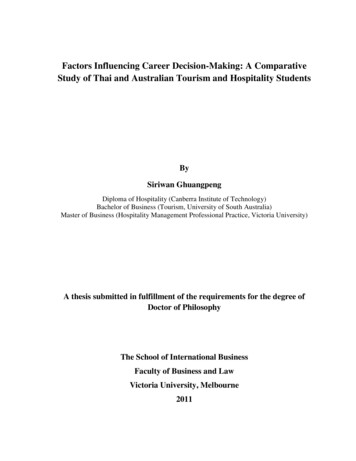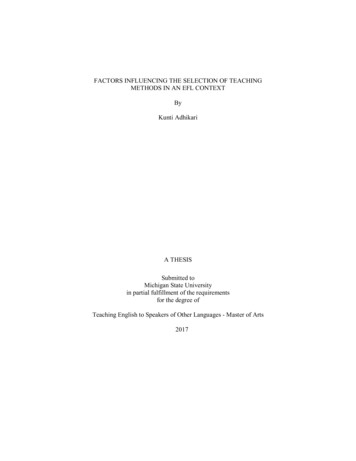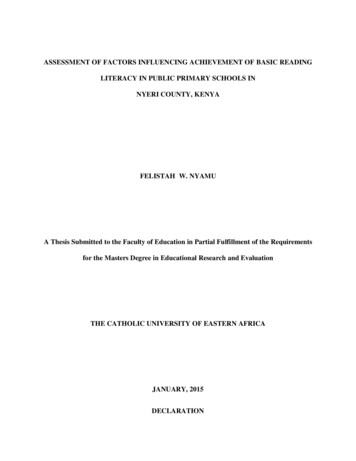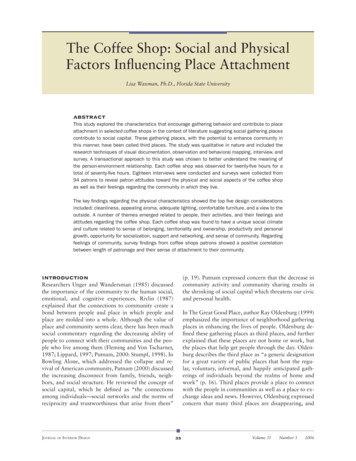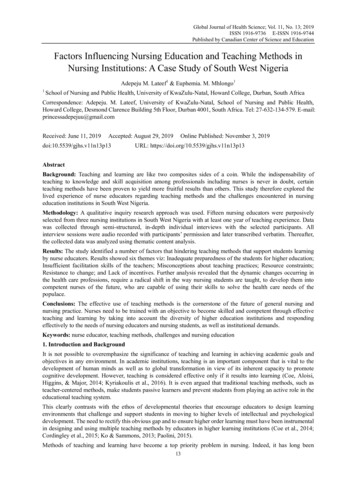
Transcription
Global Journal of Health Science; Vol. 11, No. 13; 2019ISSN 1916-9736 E-ISSN 1916-9744Published by Canadian Center of Science and EducationFactors Influencing Nursing Education and Teaching Methods inNursing Institutions: A Case Study of South West NigeriaAdepeju M. Lateef1 & Euphemia. M. Mhlongo11School of Nursing and Public Health, University of KwaZulu-Natal, Howard College, Durban, South AfricaCorrespondence: Adepeju. M. Lateef, University of KwaZulu-Natal, School of Nursing and Public Health,Howard College, Desmond Clarence Building 5th Floor, Durban 4001, South Africa. Tel: 27-632-134-579. E-mail:princessadepejuu@gmail.comReceived: June 11, 2019Accepted: August 29, 2019doi:10.5539/gjhs.v11n13p13Online Published: November 3, 2019URL: ground: Teaching and learning are like two composites sides of a coin. While the indispensability ofteaching to knowledge and skill acquisition among professionals including nurses is never in doubt, certainteaching methods have been proven to yield more fruitful results than others. This study therefore explored thelived experience of nurse educators regarding teaching methods and the challenges encountered in nursingeducation institutions in South West Nigeria.Methodology: A qualitative inquiry research approach was used. Fifteen nursing educators were purposivelyselected from three nursing institutions in South West Nigeria with at least one year of teaching experience. Datawas collected through semi-structured, in-depth individual interviews with the selected participants. Allinterview sessions were audio recorded with participants’ permission and later transcribed verbatim. Thereafter,the collected data was analyzed using thematic content analysis.Results: The study identified a number of factors that hindering teaching methods that support students learningby nurse educators. Results showed six themes viz: Inadequate preparedness of the students for higher education;Insufficient facilitation skills of the teachers; Misconceptions about teaching practices; Resource constraints;Resistance to change; and Lack of incentives. Further analysis revealed that the dynamic changes occurring inthe health care professions, require a radical shift in the way nursing students are taught, to develop them intocompetent nurses of the future, who are capable of using their skills to solve the health care needs of thepopulace.Conclusions: The effective use of teaching methods is the cornerstone of the future of general nursing andnursing practice. Nurses need to be trained with an objective to become skilled and competent through effectiveteaching and learning by taking into account the diversity of higher education institutions and respondingeffectively to the needs of nursing educators and nursing students, as well as institutional demands.Keywords: nurse educator, teaching methods, challenges and nursing education1. Introduction and BackgroundIt is not possible to overemphasize the significance of teaching and learning in achieving academic goals andobjectives in any environment. In academic institutions, teaching is an important component that is vital to thedevelopment of human minds as well as to global transformation in view of its inherent capacity to promotecognitive development. However, teaching is considered effective only if it results into learning (Coe, Aloisi,Higgins, & Major, 2014; Kyriakoulis et al., 2016). It is even argued that traditional teaching methods, such asteacher-centered methods, make students passive learners and prevent students from playing an active role in theeducational teaching system.This clearly contrasts with the ethos of developmental theories that encourage educators to design learningenvironments that challenge and support students in moving to higher levels of intellectual and psychologicaldevelopment. The need to rectify this obvious gap and to ensure higher order learning must have been instrumentalin designing and using multiple teaching methods by educators in higher learning institutions (Coe et al., 2014;Cordingley et al., 2015; Ko & Sammons, 2013; Paolini, 2015).Methods of teaching and learning have become a top priority problem in nursing. Indeed, it has long been13
gjhs.ccsenet.orgGlobal Journal of Health ScienceVol. 11, No. 13; 2019acknowledged the significance of efficient learning methodologies in nursing and medical education (Armstrong& Rispel, 2015; Rutherford-Hemming, 2012). Nurse educators are not born knowing how to teach, as such,becoming effective at teaching requires special knowledge and skills (Clark, 2008).Teaching methods among teachers and learners are critical elements of teaching and learning (Chan, 2013). Forexample, Carpenter et al. (2013) noted that teaching methodologies influence the performance of students and thefuture use of knowledge gained, so nurse educators in higher institutions of learning (HIL) should be aware of theuse of evidence-based teaching methods (Day-Black, 2015; Jinks, 2007; Patterson & Klein, 2012). According toAkiode et al. (2010), a research in Nigeria identified the need for enhancement in how nursing students are taughtin schools and clinical positioning. There is no specific teaching method that is widely acceptable, but any teachingmethod taken should be learning-oriented, student-focused, and satisfy the abilities and expertise criteria for aspecific professional skill (Devlin & O’Shea, 2012). Studies have shown that adopting innovative learningtechniques is a challenge for nurse teachers, despite being outstanding to help learners learn efficiently.Literature suggests that learners prefer the techniques of teaching that promote student learning as they help speedup the learning pace. The learning of learners is produced more efficient through active participation, and this hasa major effect on their academic performance and professional skills (Cleary, Happell, Lau, & Mackey, 2013;Day-Black, 2015). In addition, involving learners in their education enables nursing educators assess theirtechniques of teaching and enhance their abilities. Effective learning techniques then appear to be the foundationof sound education and efficient nursing practices (Kyriakoulis et al., 2016; O’connor & Yanni, 2013; Owens,2017).While it may be true that nursing educators clarify their knowledge and implementation of the concepts of teachingand learning in nursing education organizations as linked to nursing practice, there are a number of challenges thathave been hurdles to the use of teaching techniques that support student-centered learning in South West Nigeria.These include: manpower shortages, health policies, insufficient facilitation abilities, and resource constraints(Agbedia, 2012; Chopra, 2014).It has been observed that effective teaching methods are lacking in nursing educational HIL. As such, studentnurses are not able to develop their knowledge (Chi & Wylie, 2014; Chopra, 2014; Dufresne, Gerace, Leonard,Mestre, & Wenk, 1996; Nilesh, Preeti, Mayur, & Kantharia, 2011). This further strengthens the need for qualityteaching methods and effective learning of nursing students in nursing HIL (Aspegren, 1999; Devlin & O’Shea,2012; Devlin & Samarawickrema, 2010; LoBiondo-Wood & Haber, 2014). Therefore, the challenge to nurseeducators, nursing students and nursing service personnel is to work together to design a teaching methods thatsupports students learning educational system. It has also been observed that the teaching methods used forteaching and learning are directly linked to the development and transformation of the learners’ minds in thecontext of teaching and learning (Arce, Bodner, & Hutchinson, 2014; McCartney & Morin, 2005; Won & Wong,1987). As such, these challenges affecting nursing training globally and in Nigeria form the focus of this study.2. Characteristics of nursing institutes in South West NigeriaThe nursing institutes in South West Nigeria are characterized by university and hospital based education. In theuniversity based institution, the nursing students are trained on evidence based knowledge education. Its takes aperiod of five years to complete the program (Agbedia, 2012). In hospital based institution, the nursing studentstraining is more practical oriented and benefit from closed clinical supervision and mentorship from the medicalprofessionals. This program takes a period of three years (Anyigor, Ekuma, Ominyi, & Agom, 2015). This meansif an individual want to acquire a Bachelor of Nursing Science (BNSc) qualification, they attend a university basedinstitution. While someone who want a diploma certificate (RN) goes to hospital based institution3. Research DesignThe study commenced with acquisition of ethical approval from the Humanities and Social Sciences ResearchEthics Committee of the University of KwaZulu-Natal (Protocol reference number: HSS/0610/016M). The studyused a phenomenological approach to explore the experience of nursing educators in teaching methods as well asthe challenges faced by nursing education institutions in South West Nigeria. There are six states in South WestNigeria: states of Lagos, Ogun, Oyo, Osun, Ondo and Ekiti. The study was carried out in two states: Ogun Stateand Osun State. These states and the three institutions that served as the setting of the research were selected usingpurposeful sampling technique. The tertiary institutions offering Bachelor of Nursing Science and diplomaprograms were used.The study population consisted of nurse educators in selected nursing education institutions in South West Nigeriacurrently working as lecturers. The study was attended by fifteen nurse educators ranging from junior lecturers to14
gjhs.ccsenet.orgGlobal Journal of Health ScienceVol. 11, No. 13; 2019associate professors from the three nursing institutions. Data collection employed semi-structured in-depthindividual interviews with open-ended questions to gain a thorough understanding of the nurse educators’experiences as they relate to the methods of teaching they use.All interviews were first recorded in audio with the interviewees’ permission. Thereafter, the recorded audio tapeswere transcribed verbatim. Using thematic content analysis, before being analyzed using NVivo 10. The essence ofdata analysis is to show the outcome of the raw data and the key findings. In this study, the general inductiveapproach was used to analyse this qualitative study. Themes and sub-themes were developed from the raw dataafter coding process as related to the objectives of the study.4. ResultsThe findings of this study arise directed from the analysis of the raw data, not from priori expectation. Codingprocess was done after data cleaning, with the objectives of the study in mind provided a focus of the relevantinformation from the raw data. The identified challenges to effective teaching and learning in nursing educationinstitutions in South West Nigeria were classified under the following themes that emerged: Students’ inadequate preparedness for higher education Teachers’ inadequate facilitation skills Misconceptions about the practices of nursing educators Resource constraints Resistance to change Lack of inceptionTable 1. Summary of the findingsThemeIndividualSub-themesInadequate priorpreparation of the studentsfor higher education“ what I find out is that most of thestudentsarenotinterestedinlearning whatever their attitudes towardsbeing ready for class ”Inadequate facilitationskills of the teachers“we ourselves as educators know that somepeople don’t know how to demonstrate ”a)Inadequateinfrastructureb)Inadequateteaching materialsc)Staff shortagesd)Work overloade)Time constraintResource he teaching resources are usually toosmall for the students’ population that wehave ”Lack of incentives withassociated lack ofmotivation and jobsatisfaction“ teachers are one of the poorest paid inNigeria, yet remuneration is an incentivethat motivates one to teach the more and thebetter ”Misconceptions aboutnurse educators’ practices“ internet facility instead of them to use itfor what will benefit them academically; it issocial website they do log on ”“I have been trying to tell them to start usingmultimedia in teaching, but many of themare still using the old methods of lecture ”Resistance to change15
gjhs.ccsenet.orgGlobal Journal of Health ScienceVol. 11, No. 13; 20194.1 Inadequate Preparedness of the Students for Higher EducationThe study identified inadequate prior preparation of the students as a hurdle to teaching and effective learningamong nursing students. Participants reported that this lack of preparedness of the students hinders effectivefacilitation and learning. It was reported that students have problems grasping knowledge after reading and thistogether with their poor attitudes towards learning constitute challenge in the teaching-learning process. This iswell exemplified by the following interview excerpts:“ what I find out is that most of the students are not interested in learning whatever their attitudes towardsbeing ready for class ” (P07)“ students do not want to read again, that is the challenge I am facing now. Instead of them taking their booksand reading, they prefer to chat on their phones and to log on to the internet to get information. They don’t likesitting down to read. If you go to our library now, you will find just about 3 or 4 of them reading ” (P04)4.2 Deficient Facilitation Skills of the TeachersData revealed inadequate facilitation skills on the part of the teachers as another challenge to quality teaching.Participants pointed out the detriment to nursing education of a lack of competence to facilitate teaching andlearning among nurse educators. They reported that the predominant teaching pattern in nursing educationalinstitutions in Nigeria is the teacher-centered methods. The nurse educators see themselves as experts in thesubject matter, hence the students become spectators and passive learners. This challenge affects the quality of thetraining given to nursing students. The excerpt below aptly corroborates this:“ we ourselves as educators know that some people don’t know how to demonstrate, they don’t know how toexplain, we can only come to class to lecture, so that kind of a thing is also a factor that affect the teachingmethod ” (P03)4.3 Misconceptions About Nurse Educators’ PracticesMisconceptions about teaching and learning stand out equally as a major challenge in the study setting to providequality nursing education. Participants reported that students prefer taking notes in class and thus use ateacher-oriented approach to teaching. Some educators even argue that the internet is more of a distraction to thecurrent students than a learning aid. Participants also added that group presentations were not a useful method interms of facilitation. This is reflected in the following extracts:“ lecturer will do a lot of work by getting information from different sources and give it to the student becausestudents like to take notes and you want them to have a point of reference so that whatever information they giveyou in exam can be uniform ” (P02)“This internet facility instead of them to use it for what will benefit them academically; it is social website they dolog on to and that has been the source of distraction to the students.” (P01)“Like group presentation is not effective, is not beneficial but just as I said that I saw that the method is not reallybeneficial though is needed so we can cover a lot. I discovered that students do not maximize ” (P03)4.4 Lack of Incentives With Associated Lack of Motivation and Job SatisfactionLack of motivation consequent on poor incentives and other related factors stand out as another major challenge tothe teaching strategies employed in nursing education. Participants reported that they are underpaid consideringthe work they do. They expressed that this rather poor remuneration tends to weigh down their spirit culminating inlow motivation with negative consequences on individuals’ efficiency in facilitating teaching and learning. Manyrecall that the poor salaries paid to teachers, dampens morale and the teachers’ zeal at teaching and learning. Otherparticipants state that fallout of the poor incentive is a lack of job satisfaction, which equally affects facilitation ofstudents’ learning. The excerpts below buttress this further:“Another thing is that teachers are one of the poorest paid in Nigeria. We are nowhere as far as remunerationconcerned, yet remuneration is an incentive that motivates one to teach the more and the better ” (P03)“ if the government can just pay commensurable money; something commensurable to the input of the teachers itwill serve as an inducement to do better ” (P15)“ another thing is the remuneration because is ultimate for job satisfaction. You know when you see that you arenot well remunerated it can affect your job satisfaction and service delivery ” (P02)4.5 Resource ConstraintIn this study, the theme resource constraint consists of six sub-themes based on narratives of the participants. These16
gjhs.ccsenet.orgGlobal Journal of Health ScienceVol. 11, No. 13; 2019include: Inadequate infrastructure Inadequate teaching materials Shortage of staff Work overload Time limit.4.6 Inadequate InfrastructureParticipants identified inadequate infrastructure as a hurdle to the provision of conducive working environmentthat is needed for productive teaching and learning practices. A good number of the participants explained that theinfrastructures available are insufficient; in terms of classroom for the student, class size, offices for the staff andmodern gadgets that have been proven to enhance students’ engagement in class and facilitate learning. Thecomments below exemplified this:“The teaching resources are usually too small for the students’ population that we have [researcher: you mean theclassroom?] For example, my department we are short of classroom and things can be better.” (P13)“I think is getting more facilities available and of course if modernizing the structures. The trend is not using verybig large lecture theatres again but here we still use big large lecture theatres because of the large number ofstudents for a small group discussion you need a different seating arrangement not the traditional seatingarrangement.” (P15)“ lack of facilities especially ICT that can be used to enhance teaching are the major challenges. So theyshould provide facilities in terms of offices for staff, internet facility ” (P12)4.7 Inadequate Teaching ResourcesA good number of the participants equally reported inadequate teaching resources as another factor influencing thechoice of teaching methodology and quality of teaching. Interviewee explained further that resources such aselectricity, internet connectivity and anatomical models for demonstration are not readily available for use. Thequotes below bear eloquent testimony to this:“There is no light now, no fuel to run the generator, no internet connectivity All these things are frustrating andsometimes you want to throw everything away. Definitely, the output will be affected When the resources arethere, there is no reason for one not to work.” (P14)“Another challenge is in the area of facilities for teaching. For example, I teach maternal and child health.Recently, I was in the lab to teach students and hmm it was anatomy and physiology of the female reproductivesystem and I needed anatomical model. I needed manicure and manikin with other things to effectivelydemonstrate to students before they could go to the hospital but there was none.” (P12)4.8 Shortage of StaffParticipants also reported that shortage of staff is a challenge to efficient teaching practices. At present, the numberof nursing academic staff vis-à-vis the nursing students’ population has become a mismatch. While it could beargued that there are existing policies guiding student-lecturer ratio, it is obvious that they are not being adhered to.The extracts below corroborate this:“There is shortage of staff compared to number of students that we have. When the educators are less thanstipulated number of educators that should be in an institution, the strategies adopted may not be effective I thinkthat is one of the major challenges because the available educators get burnt out easily due to work overload”(P08)“There has been an astronomical increase in the number of students without having corresponding increase in thenumber of teachers.” (P15)“We are short staffed here, we are looking for teachers, so those are the things that are frustrating us.” (P06)4.9 Work OverloadWork overload is another factor identified by participants as a constraint to effective teaching and learning.Participants reported that large class sizes have a big influence on the choice of teaching and learning strategiesthey adopt. Some participants narrated further that due to work overload, students are not well equipped for thetask of being a nurse. The excerpts below buttress this:17
gjhs.ccsenet.orgGlobal Journal of Health ScienceVol. 11, No. 13; 2019“The challenge has been work overload let me say generally in Nigeria you have this large number of studentsin class and with few lecturers so you have a lot of students that you need to teach. Work overload is really high andthat has really impacted my efficiency.” (P11)“ we have seventeen academic staff for both full-time and part-time students and in the full-time programmealone we have over five hundred students. So they should hire more academic staff so that the number of coursestaken by individual lecturers per semester can be cut down, so that we can have more time to prepare for thestudent ” (P12)“You have so many classes to take okay. As a young lecturer, you have your own classes to take, you have theuniversity courses to take. Where you are not supposed to be taking more than a class, you are taking like threeclasses. Do you get that? It’s really a big challenge?” (P14)4.10 Time ConstraintTime constraint emerged as yet another constraint to quality teaching practices among nurse educators in the studysetting. Participants expressed that the lecture method has been widely adopted by nurse educators because of thelimited time allocated to teach a particular course. To this end, suitable time allocation for a course will empowerthe teachers to facilitate learning effectively. The quotes below reflect this:“ when you are lecturing you don’t engage the student; you don’t get them to participate because you aredesirous of completing what you want to give them within that limited time you have ” (P15)“In only part one regular programme we have about 100 students. So that is a huge challenge where you have toteach 100 students a concept in nursing requires discussion and demonstration but you don’t have that time. Youhave been allotted 2 or 3hours twice in a week.” (P12)“We are all on our PhD so the time is a constraint. We don’t have that time to be able to give the best to the students.So we are running our PhD full-time and at the same time teaching. I think these are the major importantchallenges we face for now.” (P12)“Most of the times I will talk about teaching-learning methods because when you are still talking about TeachingMethodologies most people are still more inclined to the concept of teaching (give). So I think the human support isanother big thing. We are still trying to do that but it is not yet established as it should be.” (P13).4.11 Lack of FundsData revealed that poor funding of higher nursing education is a huge challenge to excellence in teaching andlearning nursing. Participants argued that inadequate funding has hampered nurse educators’ engagement inquality research and knowledge generation. The extracts below speak volume to this:“You want to do research you don’t have money for research, you want to update yourself, limited resources, youhave to use your salary which is not even enough for you.” (P14)“I have to buy my own textbooks without allowances for it. I have to pay for the internet I use to get information sohmmm sometimes you have to buy the chair you sit on by yourself. so it is really a big challenge.” (P14)“Well I don’t want to go into the economy of the nation, but our remuneration, the salary we are paid is still notencouraging considering the hardship we are passing through in the system. Well, even though the pay is notencouraging, we don’t have a choice than to manage.” (P109)4.12 Resistance to ChangeThe following excerpts aptly support this:“I have been trying to tell them to start using multimedia in teaching, but many of them are still using the oldmethods of lecture, demonstration and . People don’t believe in moving forward very fast.” (P06)“Most of the time we normally limit ourselves to lecturing; we call it lecturing that is just teaching and at times weuse discussion. These are the two prominent ones we use in the classroom.” (P12)5. DiscussionThis study explores the experiences of nurse educators and challenges encountered in South West Nigeria inteaching and learning of nursing education institutions. This study highlighted a number of factors that posedchallenges to nursing student teaching and learning in South West Nigeria. An individual is influence to actionwhen they are motivated (Marquis & Huston, 2009; Martin, 2005; McLean & Mallett, 2012). From these findings,nurse educators reported inadequate preparedness of the nursing students to higher education. This hindered theeffective facilitation and learning of the students since the students had difficulties in grasping content after18
gjhs.ccsenet.orgGlobal Journal of Health ScienceVol. 11, No. 13; 2019studying besides their negative attitude towards nursing education. Contrary to the findings in (Byrne et al., 2012;Subhan, 2014) that showed learners lack interest in education and are not interested in teaching and learning, wecan conclude from our findings that learners are ill-prepared for higher education. According to participants, it isthis ill preparedness that negatively impacts learners’ ability to decode subject matter and at the same timeinfluenced by the choice of teaching methods.This study found that 67% of the participants had misconceptions that inadvertently affected the choice of teachingmethods used by nurse educators and the quality of teaching by extension. Prominent among these misconceptionsis the belief among nurse educators that nursing students prefer class note-taking rather than learning aid, and theidea that group presentations are not effective facilitation methods. This had undoubtedly helped to consolidatetraditional methods in South West Nigeria’s nursing educational institutions.From this study it is crystal clear that traditional methods are the predominant teaching methods in nursing schoolsin Southwest Nigeria. On the contrary, each student is a unique individual, and the diversity of teaching andlearning capacity among nursing students makes it hard to believe that traditional teaching methods will benefiteach learner. Furthermore, the over-reliance on traditional methods may not be unrelated to the grandioseperception of nursing educators as the custodian of knowledge and subject matter experts.The net result of a lack of diversity in the method of teaching is that students tend to become bored, frustrated, loseinterest in subject matter and thus become inadequately prepared. This finding is consistent with the submission byMwale and Kalawa (2016, p. 6) that educators’ inadequate facilitation skills are a huge challenge in nursingeducation. Moreover, these authors (Grassley & Lambe, 2015, p. 361; Khademolhosseini, Vanaki, Memarian, &Ebadi, 2012, p. 485) established that the future of nursing lies is in the quality of nursing education by nursingeducators (WHO, 2009). Others are the widespread notion that the student’s use of technology is becomingincreasingly distracted. It should be observed that the present generation of learning nursing students are not onlyliving in an age of technological explosion, they are also digital natives. Therefore, it would appear that thetechnological way is an effective method of facilitation and one that easily excites and sustains their interest inlearning. This corroborates Krau (2015) claims that learners will be motivated by the use of technology in teachingand learning to engage in teaching learning process. Therefore, technology-oriented strategy plays a major role fornursing students in Southwest Nigeria’s nursing educational institutions (Krau, 2015).The revelation that 87% of the nursing educators interviewed received poor wages coupled with a lack ofincentives resulted in poor motivation and related lethargy. This finding is similar to those found by (Eta, Atanga,Atashili, & D’Cruz, 2011; Gaber & Moustafa, 2015; A. Hussein & R. G. Hussein, 2013; Khammarnia, HajMohammadi, Amani, Rezaeian, & Setoodehzadeh, 2015; Mthiyane & Habedi, 2018; Sabari, 2012; Yelkpieri,Namale, Esia-Donkoh, & Ofosu-Dwamena, 2012), These authors identified the lack of motivation amongeducators to cause loss of job satisfaction and therefore low productivity. It should be noted that in order to beemployable, nursing educators invest so much in their own education. As such, they may be quite demoralized atthe low wages they are paid. Having this in mind, an increase in the salary of nursing educators and the provisionof incentives will most likely provide the impetus needed to improve teaching and learning in nursing institutions.Another challenge unmasked by this study is that lack of funding in institutions of nursing education adverselyaffects the quality of nursing education. A comparable research carried out in another environment (Yelkpieri et al.,2012) is identical to the results of this research that absence of funding is a challenge in
1 School of Nursing and Public Health,University of KwaZulu-Natal, Howard College, Durban, South Africa Correspondence: Adepeju. M. Lateef, University of KwaZulu-Natal, School of Nursing and Public Health, Howard College, Desmond Clarence Building 5th Floor, Durban 4001, South Africa. Tel: 27-632-134-579. E-mail: princessadepejuu@gmail.com

